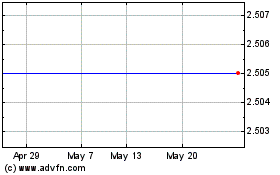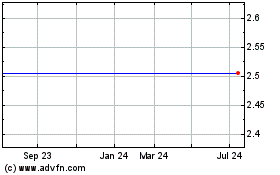Downing Three VCT Downing Three Vct 3 Plc : Final -6-
April 28 2014 - 1:58PM
UK Regulatory
Equity and Venture Capital Valuation Guidelines ("IPEV") together with
FRS26.
For unquoted investments, fair value is established using the IPEV
guidelines. The valuation methodologies for unquoted entities used by
the IPEV to ascertain the fair value of an investment are as follows:
-- Price of recent investment;
-- Multiples;
-- Net assets;
-- Discounted cash flows or earnings (of underlying business);
-- Discounted cash flows (from the investment); and
-- Industry valuation benchmarks.
The methodology applied takes account of the nature, facts and
circumstances of the individual investment and uses reasonable data,
market inputs, assumptions and estimates in order to ascertain fair
value.
Gains and losses arising from changes in fair value are included in the
Income Statement for the period as a capital item and transaction costs
on acquisition or disposal of the investment are expensed. Where an
investee company has gone into receivership, liquidation or
administration (where there is little likelihood of recovery), the loss
on the investment, although not physically disposed of, is treated as
being realised.
It is not the Company's policy to exercise significant influence over
investee companies. Therefore the results of these companies are not
incorporated into the Income Statement except to the extent of any
income accrued. This is in accordance with the SORP that does not
require portfolio investments to be accounted for using the equity
method of accounting.
Income
Dividend income from investments is recognised when the Shareholders'
rights to receive payment has been established, normally the ex-dividend
date.
Interest income is accrued on a time apportionment basis, by reference
to the principal sum outstanding and at the effective rate applicable
and only where there is reasonable certainty of collection in the
foreseeable future.
Expenses
All expenses are accounted for on an accruals basis. In respect of the
analysis between revenue and capital items presented within the Income
Statement, all expenses have been presented as revenue items except as
follows:
-- Expenses which are incidental to the disposal of an investment are
deducted from the disposal proceeds of the investment.
-- Expenses are split and presented partly as capital items where a
connection with the maintenance or enhancement of the value of the
investments held can be demonstrated. The Company has adopted the policy
of allocating Investment Manager's fees 100% as revenue.
-- Expenses and liabilities not specific to a Share class are generally
allocated pro rata to the net assets.
-- Performance incentive fees arising from the disposal of investments are
deducted as a capital item.
Taxation
The tax effects on different items in the Income Statement are allocated
between capital and revenue on the same basis as the particular item to
which they relate using the Company's effective rate of tax for the
accounting period.
Due to the Company's status as a Venture Capital Trust and the continued
intention to meet the conditions required to comply with Part 6 of the
Income Tax Act 2007, no provision for taxation is required in respect of
any realised or unrealised appreciation of the Company's investments
which arise.
Deferred taxation which is not discounted is provided in full on timing
differences that result in an obligation at the balance sheet date to
pay more tax, or a right to pay less tax, at a future date, at rates
expected to apply when they crystallise based on current tax rates and
law. Timing differences arise from the inclusion of items of income and
expenditure in taxation computations in periods different from those in
which they are included in the accounts. Deferred taxation is not
discounted.
Other debtors, other creditors and loan notes
Other debtors (including accrued income), other creditors and loan notes
are included within the accounts at amortised cost.
Issue costs
Issue costs in relation to the shares issued for each share class have
been deducted from the share premium account for the relevant share
class.
2. Basic and diluted return per share
'C' Shares 'A' Shares 'D' Shares 'E' Shares 'F' Shares
Revenue
return
(GBP'000) 162 - 221 - 15
Weighted
average
number of
shares in
issue 7,158,826 10,750,064 9,985,620 14,994,862 10,821,660
Net capital
(loss) for
the period
(GBP'000) (87) - (6) - (404)
Weighted
average
number of
shares in
issue 7,158,826 10,750,064 9,985,620 14,994,862 10,821,660
As the Company has not issued any convertible securities or share
options, there is no dilutive effect on return per share for any of the
share classes. The return per share disclosed therefore represents both
the basic and diluted return per share for all share classes.
3. Basic and diluted net asset value per share
31 Dec 2013 31 Jan 2013
Shares in issue Net asset value Net asset value
31 Dec 31 Jan
2013 2013 per share GBP'000 per share GBP'000
'C' Shares 7,158,326 7,158,326 90.7p 6,494 94.7p 6,778
'A' Shares 10,750,064 10,750,064 0.1p 11 0.1p 11
'D' Shares 9,979,109 9,994,109 76.9p 7,673 79.7p 7,969
'E' Shares 14,994,862 14,994,862 0.1p 15 0.1p 15
'F' Shares 10,821,660 10,821,660 79.9p 8,644 88.5p 9,574
22,837 24,347
The 'C' Share pool, 'D' Share pool and 'F' Share pool are treated as
separate investment pools. Within the 'C' Share pool the Directors
allocate the assets and liabilities of the Company between the 'C'
Shares and 'A' Shares such that each share class has sufficient net
assets to represent its dividend and return of capital rights. Within
the 'D' Share pool the Directors allocate the assets and liabilities of
the Company between the 'D' Shares and 'E' Shares such that each share
class has sufficient net assets to represent its dividend and return of
capital rights.
4. Principal Risks
The Company's investment activities expose the Company to a number of
risks associated with financial instruments and the sectors in which the
Company invests. The principal financial risks arising from the
Company's operations are:
-- Investment risks
-- Credit risk
-- Liquidity risk
The Board regularly reviews these risks and the policies in place for
managing them. There have been no significant changes to the nature of
the risks that the Company is exposed to over the period and there have
also been no significant changes to the policies for managing those
risks during the period.
The risk management policies used by the Company in respect of the
principal financial risks and a review of the financial instruments held
at the period end are provided below:
Investment risks
As a VCT, the Company is exposed to investment risks in the form of
potential losses and gains that may arise on the investments it holds in
accordance with its investment policy. The management of these
investment risks is a fundamental part of investment activities
undertaken by the Investment Manager and overseen by the Board. The
Manager monitors investments through regular contact with management of
investee companies, regular review of management accounts and other
financial information and attendance at investee company board meetings.
This enables the Manager to manage the investment risk in respect of
individual investments. Investment risk is also mitigated by holding a
diversified portfolio spread across various business sectors and asset
classes.
The key investment risks to which the Company is exposed are:
-- Investment price risk
-- Interest rate risk
Investment price risk
Investment price risk arises from uncertainty about the valuation of
financial instruments held in accordance with the Company's investment
objectives. It represents the potential loss that the Company might
suffer through changes in the fair value of unquoted investments that it
holds.
Interest rate risk
The Company accepts exposure to interest rate risk on floating-rate
financial assets through the effect of changes in prevailing interest
rates. The Company receives interest on its cash deposits at a rate
agreed with its bankers. Investments in loan stock attract interest
predominately at fixed rates. A summary of the interest rate profile of
the Company's investments is shown below.
There are three categories in respect of interest which are attributable
to the financial instruments held by the Company as follows:
-- "Fixed rate" assets represent investments with predetermined yield
targets and comprise certain loan note investments.
-- "Floating rate" assets predominantly bear interest at rates linked to
Bank of England base rate or LIBOR and comprise cash at bank and
liquidity fund investments and certain loan note investments.
-- "No interest rate" assets do not attract interest and comprise equity
investments and debtors.
The Company monitors the level of income received from fixed and
floating rate assets and, if appropriate, may make adjustments to the
allocation between the categories, in particular, should this be
required to ensure compliance with the VCT regulations.
Credit risk
Credit risk is the risk that a counterparty to a financial instrument is
unable to discharge a commitment to the Company made under that
Downing Three C (LSE:DP3C)
Historical Stock Chart
From Jun 2024 to Jul 2024

Downing Three C (LSE:DP3C)
Historical Stock Chart
From Jul 2023 to Jul 2024
